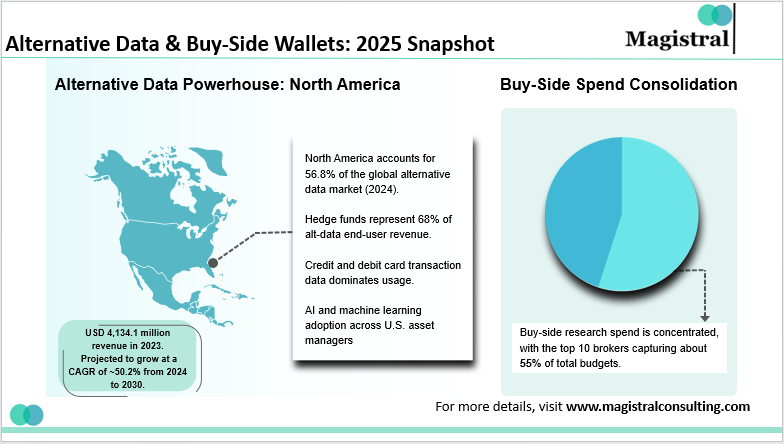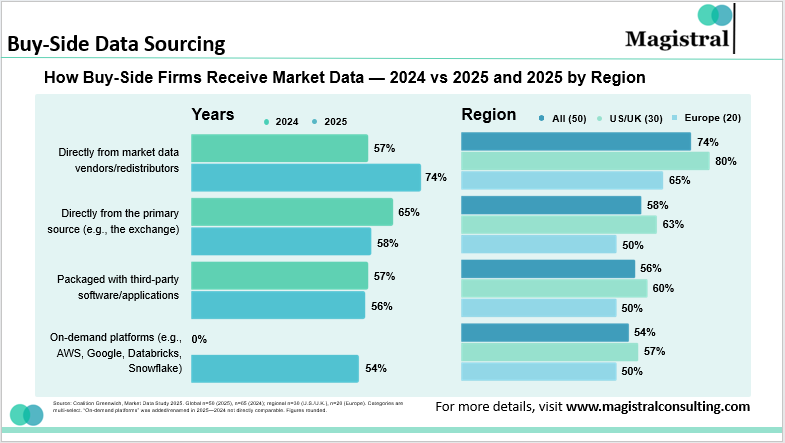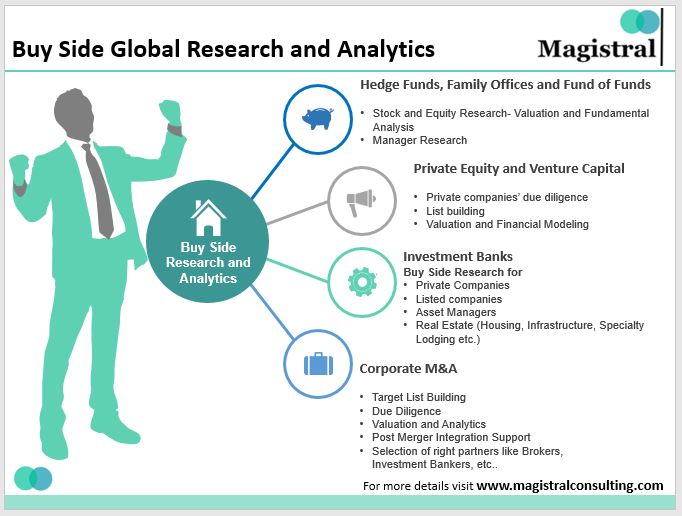Traditionally, buy-side research has drawn from corporate disclosures, analyst reports, financial statements, and earnings calls. These tools remain foundational, as they help assess revenue, costs, guidance, and management tone. But their latency and lack of granularity often limit their predictive power hurdling the fast-moving markets.

Alternative Data & Buy-Side Wallets: 2025 Snapshot
Noticing a paradigm shift, firms are increasingly incorporating alternative data into their buy-side research workflow. By enabling earlier detection of trends, uncovering hidden risks, and offering higher frequency signals, alternative data is becoming a key differentiator. Buy-side research is evolving, and alternative data is at the center of this transformation.
From Raw Signals to Strategic Intelligence: Redefining Data in Buy Side Research
The conversation around data in investment research has evolved—from acquiring more information to extracting strategic intelligence that directly impacts portfolio performance. For modern buy-side firms, alternative data represents this evolution: a transition from lagging, structured disclosures to real-time, high-velocity insights that illuminate what’s happening on the ground before it reaches financial statements.
In 2024, over 78% of institutional investors reported using alternative data in some capacity, according to an EY survey, while global spending on such datasets exceeded $11 billion, projected to surpass $135 billion by 2030. This rapid adoption is driven by one simple fact: speed and context now create more alpha than coverage and volume.
Alternative data spans a broad spectrum of sources, including:
Satellite and Geospatial Imagery
Satellite intelligence now enables investors to monitor over 10 million industrial and logistics sites globally. Firms analyze port congestion, oil storage volumes, and crop yields to anticipate macroeconomic shifts. For instance, hedge funds tracking satellite imagery of Chinese ports in early 2023 detected a 7% rise in cargo activity, weeks before official trade data confirmed economic acceleration. Similarly, energy-focused funds using satellite oil storage estimates have improved forecast accuracy by up to 20%, according to UBS Evidence Lab.
Consumer Transaction and Credit Card Data
Spending data from anonymized transactions—covering over $3 trillion in annual consumer flows globally—provides early visibility into corporate revenue trends. Hedge funds using transaction-based nowcasting models have consistently achieved 2–5% excess alpha, as reported by BattleFin and Neudata. During the 2022 holiday season, consumer card data signaled softening demand in U.S. retail. It was two weeks before corporate earnings downgrades, allowing managers to reposition portfolios early.
Mobility and Geolocation Intelligence
Mobility data derived from mobile devices and logistics sensors captures real-time patterns. It is usally in retail footfall, transportation flows, and infrastructure use. For example, during post-pandemic recovery, funds tracking geolocation data in Southeast Asia identified a 40% rebound in mall footfall months before macro indicators reflected consumer recovery. This early visibility has become particularly valuable for frontier and emerging markets where official statistics are sparse or delayed.
Digital and Social Sentiment Analytics
AI-driven sentiment models now process over 100 million social and news data points daily, converting digital chatter into quantitative market signals. A 2024 study by Refinitiv showed that sentiment-based trading strategies improved short-term return predictability by 18–25%, particularly around earnings announcements and regulatory events. For asset managers, this offers a real-time pulse of investor psychology and reputational risk.
ESG-Linked and Sustainability Data
ESG-focused datasets now extend beyond corporate disclosures, incorporating sensor-based emission tracking, NGO datasets, and supply chain audits. According to MSCI, over 65% of global institutional investors now use ESG alternative data to complement due diligence and risk scoring. Firms integrating satellite-based pollution data into ESG models have reduced “greenwashing exposure” by up to 30%, improving portfolio credibility and alignment with sustainable mandates.
But the real breakthrough is not just access—it’s integration. The leading buy-side firms are developing multi-source data architectures that blend fundamental analysis with real-time signals, feeding directly into predictive models and risk dashboards. This has shortened research cycles, improved portfolio rebalancing agility, and delivered tangible performance improvements.
For C-suite leaders, this shift marks a deeper strategic pivot: buy-side research is no longer about information accumulation, but about intelligence synthesis—where foresight, speed, and contextual precision define the competitive edge.
Operationalizing Alpha: How Leading Firms Translate Alternative Data into Performance
The true trust of alternative data for the buy-side lies not only in the access, but mainly in the execution part, for determining how effectively it can be integrated into portfolio construction, research, and risk oversight. The top performers in asset management have evolved beyond experimentation, embedding these signals into systematic workflows that directly influence alpha generation and capital allocation. Below highlights the breakdown of how top managers are transforming disparate datasets into structured intelligence and the measurable gains that follow:

Buy-Side Data Sourcing
Accelerating Insight Cycles Through Unified Data Pipelines
Leading buy-side firms are integrating satellite, transaction, ESG, and sentiment data into unified pipelines, reducing research latency by up to 35%. Goldman Sachs reported decreasing trade signal latency from 120 milliseconds to 14 milliseconds, enhancing responsiveness to market opportunities.
Embedding Predictive Models into the Investment Framework
Over 70% of advanced hedge funds apply machine learning to alternative datasets, improving forecast accuracy by 20–30%. A PwC report highlighted that hedge funds utilizing alternative data and AI achieved 20% higher alpha generation in 2024 compared to those that didn’t.
Governance, Transparency, and Data Integrity as Competitive Differentiators
With 58% of asset managers embedding compliance checkpoints into data ingestion workflows, firms are enhancing data quality and regulatory adherence. This institutionalization of data governance is crucial as regulators tighten oversight on data sourcing under evolving privacy and AI transparency laws.
Demonstrable Alpha from Integrated Signals
Funds combining mobility, transaction, and ESG data report basis-point gains across core books. For instance, a quant fund merged geolocation and transaction data in its consumer retail portfolio, generating 280 basis points of alpha when footfall dropped 6% year-on-year, validating the predictive power of integrated alternative data.
The evolution of buy-side research is no longer incremental. Alternative data has become a core driver of alpha, risk management, and portfolio foresight. Hedge funds using transaction-based nowcasting achieve 2–5% excess alpha, while satellite-driven commodity forecasts improve accuracy by 15–20% (UBS Evidence Lab). Leading firms integrate satellite imagery, geolocation intelligence, social sentiment, and ESG datasets into unified workflows. This approach compresses insight-to-action cycles and helps anticipate earnings surprises and ESG or macro risks before the broader market.
Over 58% of institutional investors now embed compliance checks into alternative data pipelines. For senior leaders, the message is clear: integrating alternative data into buy-side research is no longer optional. It is the strategic edge that drives portfolio performance, predictive accuracy, and competitive advantage in modern financial markets.
Magistral’s Services for Buy-side research
Magistral Consulting offers comprehensive buy-side research services designed for institutional investors, including private equity, hedge funds, and asset managers. Magistral’s expertise spans equity and sector research, financial modeling and valuation, deal sourcing, and due diligence, ensuring informed investment decisions. Here’s a clear, structured list of Magistral’s buy-side research services:
Equity and Sector Research
In-depth analysis of companies, industries, and market trends to support investment decisions.
Financial Modeling and Valuation
Building robust financial models, forecasts, and valuation frameworks to evaluate potential investments.
Deal Sourcing and Origination
Identifying and screening investment opportunities aligned with clients’ strategic objectives.
Due Diligence Support
Conducting detailed operational, financial, and market due diligence to mitigate investment risk.
Portfolio Management Assistance
Helping clients monitor, optimize, and rebalance portfolios for performance and risk management.
Investor Outreach and Reporting
Preparing reports, pitch materials, and presentations for stakeholders and potential co-investors.
ESG and Risk Analytics
Integrating environmental, social, governance, and other risk factors into investment evaluation.
Global Market Insights
Providing actionable intelligence from international markets to support cross-border investment strategies.
About Magistral Consulting
Magistral Consulting has helped multiple funds and companies in outsourcing operations activities. It has service offerings for Private Equity, Venture Capital, Family Offices, Investment Banks, Asset Managers, Hedge Funds, Financial Consultants, Real Estate, REITs, RE funds, Corporates, and Portfolio companies. Its functional expertise is around Deal origination, Deal Execution, Due Diligence, Financial Modelling, Portfolio Management, and Equity Research
For setting up an appointment with a Magistral representative visit www.magistralconsulting.com/contact
About the Author

Dhanita is a BD and Marketing professional with 6+ years’ experience in sales strategy, growth execution, and client acquisition; credentials include Stanford Seed (Stanford GSB), an MBA from USMS–GGSIPU, and a B.Com (Hons) from the University of Delhi. Expertise spans market research and opportunity mapping, sales strategy, CRM, brand positioning, integrated campaigns, content development, lead generation, and analytics; currently oversees business development calls and end-to-end marketing operations
FAQs
How does Magistral support portfolio management for buy-side clients?
How does Magistral integrate ESG into its services?
Does Magistral support deal sourcing and investor outreach?
How does Magistral help clients in investment decisions?
What buy-side research services does Magistral offer?

